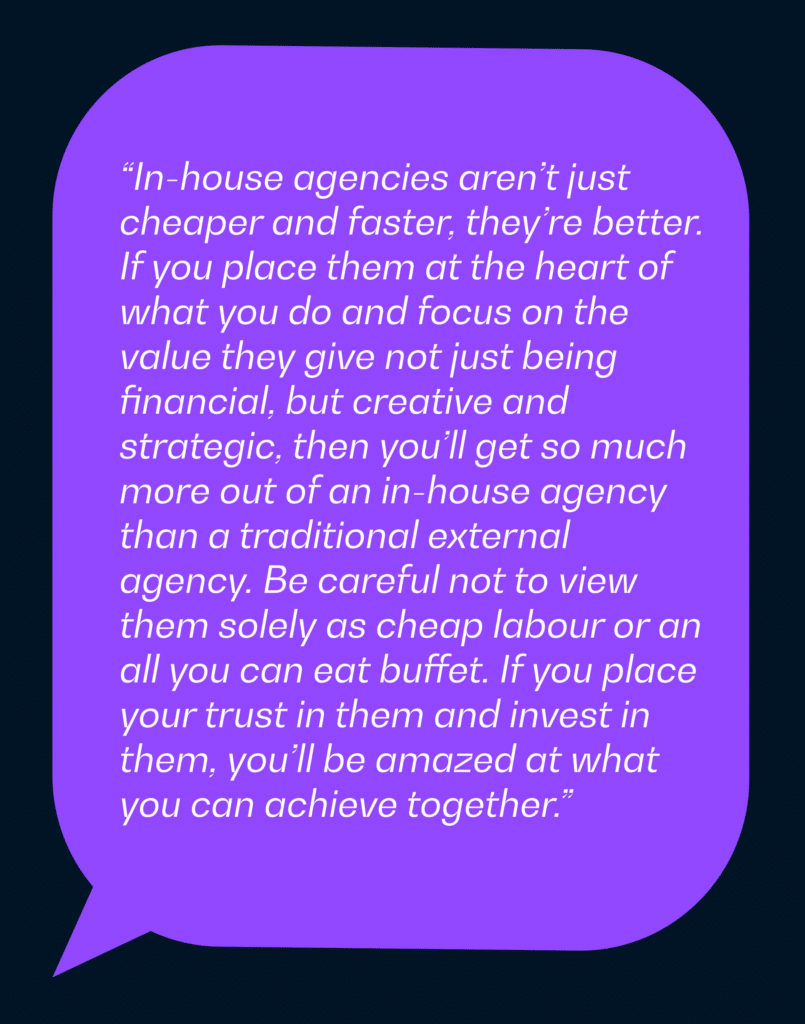What is the power and potential of having a creative function within an organisation?
For the last question in our recent Talent & Salary Survey, we asked leaders to tell us what they thought the big opportunities were for talent in-house. The answers provide not just a great summary of what is driving people to leave external agencies for in-house roles, but also the basis for having an internal creative team/agency/department in the first place.
Cost will always be a factor, if not the factor for having an in-house agency. Much as we might like to think that saving money is now a given and that we can concentrate on the wider value an IHA can bring, the way that businesses operate mean that demonstrating savings versus external agencies will always be essential. It’s a tangible, direct, easily understood benefit. And it will always underpin any arguments or business case for expanding the remit of the in-house team.
But that doesn’t necessarily just mean proving that the work can be produced at lower cost. Effectiveness should also be part of the argument – that the work will be more cost-effective as well as cheaper, and that it will deliver better ROI for the business.
Why will it be more effective? That brings us to the wider value of in-house agencies.

As one respondent told us in the survey: “In-house agencies aren’t just cheaper and faster, they’re better. If you place them at the heart of what you do and focus on the value they give not just being financial, but creative and strategic, then you’ll get so much more out of an in-house agency than a traditional external agency.”
IHAs have incredible knowledge of the brand (and access to data), together with a deep understanding of how that brand lives and breathes. But because they are also exposed to the complexities of a company’s values and ambitions, as well as how it works, and how to collaborate with stakeholders, creative solutions can be aligned and optimised for maximum effect. As one respondent told us, “In-house creative teams are increasingly being entrusted with greater responsibility and ownership as businesses recognise their crucial role in driving brand and company growth. This presents in-house talent with the opportunity to significantly shape and take long-term ownership of the brand while working on a diverse array of projects.”
The strategic value of the in-house agency, of having that creative resource as part of the business, combines two seemingly opposed qualities: one the one hand, creativity and innovation, on the other, consistency and control.
In March this year, Helen Edwards wrote a highly-persuasive argument for the role of Chief Creative Officer on the Marketing Week website. She acknowledged that this role already exists in certain sectors – fashion and media, for example – but that “even businesses in the most routine sectors will need to bring imagination and originality to bear if they are to outcompete rivals and not just stay tamely inside the boundaries of category norms.”
Having a CCO working alongside a CMO, she argued, will bring “unity and originality to every aspect of the outward-facing expression of your brand”. (Note the use of the word ‘unity’: yes, in-house creative teams can provide transformational solutions to business problems, but their brand knowledge can also ensure that all-important consistency in the way that consumers experience the brand across every touchpoint.)
But these qualities of imagination and originality, expressed in a way that is consistent with the brand, do not have to be embodied in an individual. Rather, they are at the heart of the value of the in-house creative team as a whole.
Specsavers is renowned for the creative quality and effectiveness of the advertising its in-house team produces. But earlier this year, it decided to ditch the term ‘agency’ and instead changed its name to Specsavers Creative. Why? In part because it wanted to articulate the wider impact it was having on the business. At Specsavers, Creative is a department among equals, sitting alongside finance, HR and so on. Its role is to apply its particular expertise to drive the growth of the business, just as the other departments do. It’s not a service department, it’s a strategic partner. And it doesn’t just wait to be asked – it’s proactive and engaged in more than just responding to marketing briefs.
In order for organisations to realise the opportunity that having a knowledgeable, agile, effective and innovative creative department offers, it seems obvious that such a department needs to be involved in the conversations that matter, at a stage when its expertise can make a difference. Why bring creativity in-house if you are not going to bring it into the room when the organisation is discussing the most important challenges it faces?

